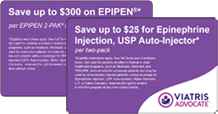
Safety considerations
EPIPEN® (epinephrine injection, USP) 0.3 mg and EPIPEN JR® (epinephrine injection, USP) 0.15 mg Auto-Injectors-as well as their authorized generics- should only be injected into the anterolateral aspect of the thigh. Do not inject intravenously, into buttock, or into digits, hands, or feet. Instruct caregivers to hold the leg of young children firmly in place and limit movement prior to and during injection to minimize risk of injection-related injury.
Epinephrine should be used with caution in patients with heart disease, and in patients who are on drugs that may sensitize the heart to arrhythmias, because it may precipitate or aggravate angina pectoris and produce ventricular arrhythmias. Arrhythmias, including fatal ventricular fibrillation, have been reported, particularly in patients with underlying cardiac disease or taking cardiac glycosides, diuretics, or anti-arrhythmics.
Patients with certain medical conditions or who take certain medications for allergies, depression, thyroid disorders, diabetes, and hypertension, may be at greater risk for adverse reactions. Common adverse reactions to epinephrine include anxiety, apprehensiveness, restlessness, tremor, weakness, dizziness, sweating, palpitations, pallor, nausea and vomiting, headache, and/or respiratory difficulties.
There are no absolute contraindications to epinephrine administration for an anaphylactic reaction.1-3
Storing the EPIPEN Auto-Injector and Its Authorized Generic
EPIPEN and EPIPEN JR Auto-Injectors and Epinephrine Injection, USP should be stored in the carrier tube provided at a temperature of 20-25 °C (68-77 °F); however, temperature excursions between 15-30 ºC (59-86 ºF) are permitted.1,2 EPIPEN, EPIPEN JR, and Epinephrine Injection, USP Auto-Injectors should not be stored in refrigerators or in a vehicle's glove box.1,2 EPIPEN Auto-Injectors and their authorized generic auto-injectors should not be exposed to extreme heat or cold and should be protected from light.1,2
Disposing of a used EPIPEN or Epinephrine Injection, USP Auto-Injector
It is important to communicate to your patients that used EPIPEN and Epinephrine Injection, USP Auto-Injectors must be disposed of properly.4 They should be taken to a healthcare professional’s office or to a hospital for proper disposal.1,2 Also, remind your patients to obtain a replacement for any used EPIPEN Auto-Injector or its authorized generic.1,2
How chemically stable is epinephrine?
Epinephrine solution deteriorates rapidly on exposure to air or light, turning pink from oxidation to adrenochrome and brown from the formation of melanin. Patients should be instructed to visually inspect the epinephrine solution periodically for particulate matter and discoloration. Patients should also be advised to replace their EPIPEN or EPIPEN JR or Epinephrine Injection, USP Auto-Injector if the epinephrine solution contains particulate matter or develops a pinkish or brown color, because these changes indicate that the effectiveness of the drug product may have decreased or been affected. It is important to follow recommended storage conditions.1,2
How should EPIPEN Auto-Injector or its authorized generic be carried?
Until EPIPEN or the Epinephrine Injection, USP Auto-Injectors need to be used, they should be carried in the protective case with the blue safety top on.1,2
My patient accidentally injected himself/herself with EPIPEN Auto-Injector (or its authorized generic). What should I do?
Because epinephrine is a strong vasoconstrictor, accidental injection into fingers, hands or feet may result in decrease or loss of blood flow to these areas.1,2 The patient should be advised to go immediately to the nearest emergency department and to inform the healthcare professional in the emergency department of the location of the accidental injection.1,2 Patients are also instructed to ask for a refill prescription.1,2
Special Offers
Viatris offers Access and Savings Programs for eligible patients. See Terms and Conditions.
There’s only one recommended first line treatment for anaphylaxis.
heading
Important Safety Information (the following information applies to both EPIPEN and its Authorized Generic)
EPIPEN (epinephrine injection, USP) 0.3 mg and EPIPEN JR (epinephrine injection, USP) 0.15 mg Auto-Injectors are intended for immediate administration as emergency supportive therapy only and are not intended as a substitute for immediate medical or hospital care. In conjunction with the administration of epinephrine, the patient should seek immediate medical or hospital care. More than two sequential doses of epinephrine should only be administered under direct medical supervision.
Rare cases of serious skin and soft tissue infections have been reported following epinephrine injection.
References
- EPIPEN [prescribing & patient information]. Morgantown, WV: Mylan Specialty L.P.; 11/2021.
- Epinephrine Injection, USP [prescribing & patient information]. Morgantown, WV: Mylan Specialty L.P.; 12/2020.
- Simons FE. Anaphylaxis: recent advances in assessment and treatment. J Allergy Clin Immunol. 2009;124(4):625-636.
- Jones TS, Coffin PO. Preventing blood-borne infections through pharmacy syringe sales and safe community syringe disposal. J Am Pharm Assoc (Wash). 2002;42(6)(suppl 2):S6-S9.

This site is intended for US healthcare professionals.
If you are a patient, please check out our site for patients.

Prescribing Information
Please select from the following:

Patient Information
Please select from the following:



